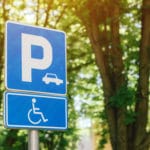In layman’s terms, a Vulnerable Road User (VRU) is any person, vehicle, or creature sharing the roadways that have less protection than your average road user would. In this next section of our course, we will be examining different classes of vulnerable road users, what makes them less protected, and how we should act accordingly when sharing the roadways with them. Let’s examine some of the classes of vulnerable road users.

Pedestrians: Anytime you are in an urban area, you are bound to see people walking along, and across the street. As a driver, as soon as we get out of the vehicle we become a pedestrian and should be aware of our responsibilities. When you are driving always make sure that you are aware of the pedestrians around you. You know to be extra careful if you are near a park, library, crosswalk, or school zone where pedestrians frequent.
People walking along streetways are an obvious class of vulnerable road user because they have no outer armor like a car does. If a human pedestrian is involved in a vehicle collision, they are defenseless. Different types of pedestrians include: highway/road workers, emergency services workers, persons in wheelchairs, skateboarders, roller skaters, and anyone using an assisted mobility device that is utilizing a public roadway.

Disabled/Blind Persons: At any given time, people who are blind or visually impaired can travel and cross streets using a human guide, using a long, white cane to identify and avoid obstacles, using a dog guide, using special optical or electronic aids, or using no additional aid. Whatever aid is used, street crossing is comprised of a number of tasks. If a blind person is at a street with no light, then he or she can simply listen for any oncoming vehicles. If no cars are heard, then they can go ahead and cross. Some intersections have Accessible Pedestrian Signals (APS) to assist people with visual impairments in determining when it is safe to cross the street.
Bicyclists: It is highly likely that many of us have shared the road with bicyclists at some point in our driving experience. Bicyclists are often found on the roadways or in their respective bicycle lane. A bike lane can be identified by an image of a bicycle painted on the bike lane or a sign next to the lane. Bikes are considered vehicles, so they belong on the road pavement when there isn’t a bike lane or if the bike lane is unsafe for them to use. However, it is important to note that bicycles are also considered a category of vulnerable road user because, like pedestrians, if a bike is involved in a collision they are defenseless.

Motorcycles: While motorcycles and autocycles are not as common as regular passenger vehicles, it is still highly likely that you have encountered them on the road. Motorcycles are popular in urban areas due to their low gas mileage and maneuverability. Autocyclists are considered a VRU because they have little defense when it comes to automobile collisions. Like bicycles, it is important that all drivers know the correct protocol when it comes to sharing the road with autocyclists.
If you or someone you know has been cited for a traffic infraction regarding driver/VRU interaction, they may be able to get their fine reduced by taking traffic school. If you are eligible to take a driver improvement course for your traffic citation, we highly recommend Cheap Easy Fast Online Defensive Driving. The course is entirely free to try, and it’s approved by all California courts. They also operate online and video courses in other states. Check their website to see if your state is included. Until next time, keep your eyes on the road!
